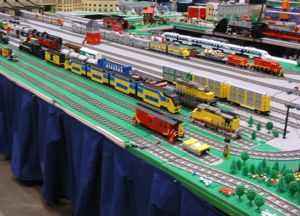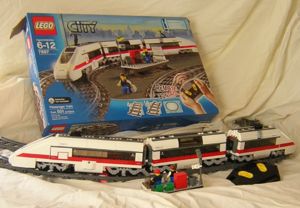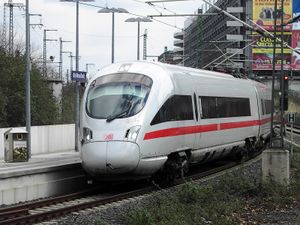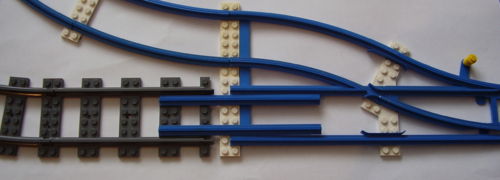Lego train

Lego Train is a theme in the Lego Group products. The sets include locomotives, tracks, rolling stock, trackside buildings (such as stations, signal houses, etc).
Contents
History
The history of Lego trains can be divided in four distinct eras.
The blue era (1966-1979)
The blue era is named after the colour of the rails.
1969 saw the introduction of Lego trains with Lego set number 080. The first train sets were push trains. Set number 115 introduced 4.5V battery operated trains (a railcar carried the batteries to supply power to a motor in the locomotive) and train sets numbered 720 (1969) and up operated on 12 Volt electrified rails.
The grey era (1980-1990)
In 1980 the trains theme got a major overhaul. The colour of the tracks changed to grey (hence the name) and the transformer changed to support utility functions as remotely-controlled points, signals, wagon decouplers and crossings. Not just the tracks changed colour - the models themselves changed to a much more realistic appearance. Models were offered with much longer carriage/wagon bodies (although still considerably short of true scale length), proper swivel bogies and special windows which simulated having a pull-down glass section.
The 1980 train catalog enticed Lego fans with nighttime dioramas featuring lampposts and lights inside the trains. Notable trainsets include the Electric Intercity (7740) and Steam Locomotive (7750) (for its large wheels). Many old 12V models (such as 7740) are now highly-prized additions to some 9V layouts as a change of motor is all that is required for compatibility.
Trains and tracks of the blue era are compatible with the grey era.
Blue and grey era trains were never officially introduced to the United States - the first train sets to go on sale were 9V models.
The 9V era (1990-present)
1990 saw again a major overhaul in the train line. Tracks gained a new realistic appearance with (9V) power coming directly from the rails - in the blue and grey era electric trains were powered by an extra electrified (12V) piece of track between the rails. The new line abandoned the 12V power in favor of the 9 volt system to make it compatible to the battery operated elements found in the Lego Light and Sound line of sets. The remote-controlled accessories from the 12V system were also abandoned, with only manual point control available and no signaling capabilities. This effectively reduced the maximum practical size of the layout as well as the complexity of train operations that could be supported. This product re-design was formulated by The LEGO Company thinking at the time, which promoted simplification in all product lines, but drew criticism for reducing the "playability" of LEGO toys.
The 12V locomotives were not compatible due to the change in voltage and means of powering the motor, but many can be retro-fitted with 9V motors. The gauge did not change, therefore older rolling stock could still be used. However, the rails and wheels now have a different profile, and some users have found that 4.5V/12V wheels may have trouble passing through 9V switches.
The future of 9V trains is uncertain as it in the process of either: 1) Being phased out and replaced by the Infra-Red system; or 2) Being kept as a Hobby train line available exclusively from the Lego Online Shop, Shop@Home. As of late 2006, The LEGO Company was considering announcing a decision in the first half of 2007.
The Lego RC Train Era (2006-present)
In 2006, Lego introduced a new train line, the remote controlled train. In an effort to reduce the cost of the track and make it easier for newcomers to enter the Lego Train community, Lego started making track entirely made out of plastic (foregoing the metal rails), and introduced a new train motor that runs on batteries and is remotely controlled via infrared (IR) remote control. This move has proven to be controversial in the Lego Train community, as the future of the 9V train system, which Lego train hobbyists favor, is currently in limbo. As of April 2006, The Lego Company has said that they will still sell 9V train pieces, but only through their online shopping service, Shop@Home (which only ships to a few countries) and in Lego retail outlets. They will rename the 9V line "The Lego Hobby Train" and plan to make a final determination about its viability sometime in 2007.
The introduction of the IR line has some benefits, notably:
- Less expensive track, as track sections do not have have metal strips on the rails.
- The decreased production costs have already resulted in a new track piece being added to the system for 2007 (the double flying cross-over).
- Remote control allows for the independent control of multiple trains simultaneously. The 9V system allowed the speed of the train(s) to be controlled only by varying the voltage of the track, so any trains on the track would be controlled at the same time. The first released sets (2006) have 3 different IR channels available allowing 3 three trains to be run at different speeds and in different directions.
- Remote control also allows for one train to be controlled by multiple controllers—-useful for a user at each end of a line, particularly when the line ends are out of IR range of each other.
- More complicated track layouts can be created without having to worry about the electrical polarity of the rails (both the 12V system and 9V system have this problem because one center conductor (12V) or rail (9V) was meant for the positive terminal and the other rail for the negative terminal).
However, the IR system also introduces some new issues:
- Infrared is not an ideal remote control system, as fluorescent lights and physical objects may interfere with it. The range is inferior to radio control.
- The trains use regular 1.5V AA-cell batteries, instead of using a more powerful rechargeable system. Previous generations of (12V and 9V) LEGO trains were mains-powered, avoiding battery-charging issues completely. The remote control uses 3 AAs and the train power unit uses 6, for a total of 9 AA batteries in use at any given time.
- Initial anecdotal reports have raised concerns about the power output of RC motors, since they are now battery based, rather than picking up an almost infinite source of current from the tracks, as with the 9V system.
Community
Lego trains are very popular amongst AFOLs (Adult fans of LEGO). Various Lego Train Clubs (LTCs) exist around the globe. A worldwide Lego train organization ILTCO was founded to channel common LTC interests and to promote Lego railroading as model train standard (named "L gauge" similar to model railroad gauges such as "Z", "N" and "HO").
The relatively-low popularity of LEGO trains due to their expense has seen the slow withdrawal of trains from regular retail outlets; currently Lego Shop-at-home (which only ships to a few countries) and Lego retail stores are the only reliable source of LEGO train sets and elements.
A number of LEGO® train clubs exhibit large model train layouts made of Lego bricks at various community functions, train shows, and Lego conventions, such as BrickFest. Some of the largest layouts in the United States have been the result of combined efforts by several train clubs at the 2005 and 2006 NMRA national conventions. Lego Direct has also introduced train sets built by members of the Lego community (for example, model 10022 by James Mathis), and plans to introduce additional train factory sets in the first half of 2007.
Some enterprising members of the community have also produced small runs of rolling stock or train sets of their own designs sold through BrickLink or personal websites.
Models
The early Lego train series of sets were developed in Germany. Many of the sets in the grey era are modeled after or inspired by real train models in use by the Deutsche Bahn (yellow/red for electric trains, black over red for steam locomotives). A few sets have been based on other prototypes - for example the French TGV trains and Swiss "Krokodil" engine.
Recent models are modeled after United States trains, reflecting the introduction and subsequent popularity of LEGO Trains in the US: the Santa Fe Super Chief (10020) and Burlington Northern Santa Fe (10133) Locomotive.
Lego modeled the fictional Hogwarts Express (4758) under the Harry Potter license, although the model is neither powered nor does it use the correct type of wheels to be a true LEGO Train model. In 2005, Lego offered a 9V motorized Hogwarts Express, (10132), which was discontinued again in 2006.
Track
There are four different track types: blue, grey, 9V and RC.
Blue tracks are constructed of 2x8 plates as sleepers and pieces of rail. The rails are straight, inner curve and outer curve pieces. The straight pieces and outer curve pieces are grooved on the top to facilitate friction with the drive wheels of powered engines. The inner curve pieces have a smooth finish. The rails are only connected at each end on the sleeper with no intermediate sleepers. When laying out the track, this system is susceptible to distortion which can vary the gauge and lead to derailment.
The grey track introduced in 1980 was an improvement of the same design, with modifications to the rails and a new sleeper plate which included special clips to hold the track together more firmly. In addition, fixing points for intermediate sleepers were provided at the mid-point of each rail making the construction even more sturdy.
For both blue and grey tracks, electrical power (for 12v trains) was provided by means of separate conductor rails placed in between the running rails. It was possible to upgrade from battery power to 12v electrical power simply by purchasing an electric motor unit, transformer and sets of conductor rails (with the exception of special track pieces such as points and crossovers which were available in separate 12v versions, with the electrical connections included).
9V and RC tracks are one piece sections of straight and curved track. The sleepers are formed as one piece with the rails making for a more reliable gauge and turning radius. There are a number of intermediate sleepers which give strength to the piece, but also lend a more realistic appearance to the track. The attached sleepers are made to look like independent 2x8 plates, except for the end sleepers which are special. These end sleepers are shaped like 1x8 plates but have a connectors that allow the tracks to click together. When the end sleepers of two track pieces are together, the end sleepers combine to look like one 2x8 plate.
The track from all four eras are somewhat compatible. The gauge has remained the same throughout, as has the turning radius of the curved pieces. The points vary in configuration which may make laying out combined systems awkward. The end to end connection of the blue and grey track types with the 9V and RC track types only requires some "Lego" ingenuity on the part of the user. Of course, the 9V engines must be restricted to the 9V rails to operate.
Specialized pieces are available as points and track cross sections. Matt Bates created a program called "Track designer" to plan track layouts on the computer [1].
External links
- Official Lego train web page
- ILTCO
- Save 9V Trains website
- notes on track layout
- Everything LEGO train plus Track Designer program
| Lego | History of Lego | Timeline | |
| Products: | Themes | Computer and video games | Mindstorms | Duplo | Pneumatics | Lego Baby | Minifigures | Trains |
|---|---|
| People: | Ole Kirk Christiansen | Godtfred Kirk Christiansen | Kjeld Kirk Kristiansen | Jørgen Vig Knudstorp |
| Legoland: | Legoland Billund | Legoland California | Legoland Deutschland | Legoland Windsor |
| Other: | AFOL | The Brick Testament | BrickFest | Brickfilm | FIRST Lego League | Irregular Webcomic! | L gauge | LDraw | Lego Serious Play | Lego Magazine | LUGNET | MLCAD |



